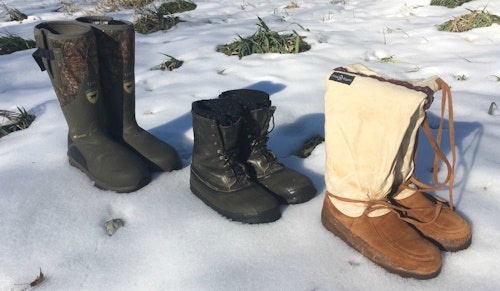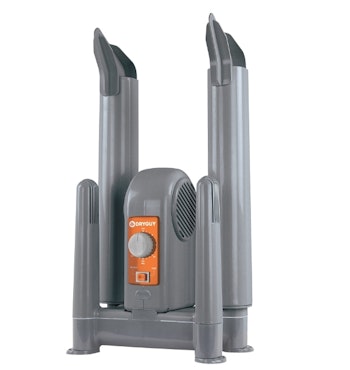December deer hunting in the Midwest can be so cold it’s almost unbearable. Almost. The key to staying in the field — and staying in the game for late-season whitetails — is remaining warm enough to execute a well-placed shot during the moment of truth.
Notice I said “remaining warm enough.” I did not say you won’t be cold. It’s an important distinction.
When temps are in the single digits or below zero, or even in the low 20s matched with high winds, avoiding the feeling of being cold isn’t possible. You will feel cold. The key to remaining on stand hour after hour is managing the cold.
What I’m saying is on certain cold-weather days, you simply must be prepared to be cold, even if you dress properly. The fact that your fingers, toes and face are cold doesn’t mean you have to head back to the truck. Managing the cold means just that — you feel the cold, understand that you’ll likely be cold for hours, and yet it’s tolerable. You stay in the stand. You keep hunting. Or as my dad used to say, “You stick it out.”
Let me be clear: I’m not suggested you sit on stand for so long and become so cold that the situation becomes dangerous. Hypothermia is real. I won’t spend time detailing the signs of hypothermia in this article; click here for more information on this medical emergency.
I am suggesting that with the right mindset, matched with the right clothes and gear, that you can manage the cold, stay safe in the field, and not be in danger of hypothermia, frost bite, etc.

How to Stay “Warm Enough”
My experience in deer hunting in frigid Midwest conditions dates back to the mid-1970s. I’ve dressed wrong in the past, but I do better today. I still get a little cold, but it doesn’t cause me to run for the truck.
Specifically, here are the steps I take to stay warm enough on stand to make a shot when the opportunity arises.
- Dress in layers. When it’s very cold (single digits or lower), I’ll wear five layers on the bottom and as many as seven layers on the top. On the coldest days, I’ll wear a Heater Body Suit. (Click here for an article on how I use this innovative suit.)
- No cotton clothing.
- Hats, gloves and boots are key. More on that later.
- Avoid sweating on your hike to the stand.
- Digestion helps your body stay warm. Eat nutritious and filling food just prior to going into the field, and pack snacks such as granola bars to keep your body furnace burning while on stand.
- Exercise in the stand without moving so much as to alert deer. You can change positions from sitting to standing occasionally, and stretch by leaning forward and backward while standing, roll/rotate your shoulders forward and backward while sitting or standing, wiggle your toes, stretch your feet by pointing your boots/feet, stand on your toes, move your head side to side and up and down, etc.
- When it’s really cold and the above exercises and stretches aren’t getting it done (keeping me warm enough to make a shot), then I’ll climb down and up from the treestand a few times. Of course, this is best done while staying connected to the tree with a Hunter Safety System Lifeline or similar product. Note: Climbing down and up from a treestand will alert nearby deer, so I use this technique only as a last resort to stay warm.
This next bit of advice might sound a bit crazy, but I’ll pass it along anyway: When it’s not bitterly cold outside, which is most days, I’ll skip the above “exercise in the stand” advice and instead simply let my feet and hands get cold. When you don’t move during frigid conditions, the blood vessels in your hands and feet will constrict, which reduces blood flow to these areas.
What I’m saying is if you go the “exercise in the stand” route, you must be committed to continuing it during the duration of your sit. If you don’t, then your hands and feet will begin to cool. Most of the time I decide I can manage the cold without exercising/stretching in the stand, and allow my hands and feet to get cold but not so cold I can’t function and shoot accurately. Sure, I’ll have to deal with a bit of pain when my hands and feet have blood pushing through them again while hiking out of the stand at the end of my hunt, but it’s a trade I’m willing to make.
Hats, Gloves and Boots
I mentioned earlier that hats, gloves and boots are key. The reason is while you can wear multiple layers on top and on the bottom to keep your core sufficiently warm, you can wear only so much on your head, hands and feet.
On my head/neck area, I’ll always wear a neck gaiter. This helps trap the warm air in my chest and blocks it from leaving around my neck (remember, heat rises). Next, I’ll wear a face mask. My favorite is the Under Armour ColdGear Balaclava. I can breathe through it, and it’s thin enough to not affect my anchor point and shooting while bowhunting. Next, I wear a thin stocking cap like the Sitka Beanie, and over that I wear a thicker, insulated stocking cap such as the Gamehide Knit Hat. Yes, two hats are much warmer than one.

On my hands, I wear a Gore-Tex glove with heavy Thinsulate insulation on my left hand. (I’m a right-handed shooter.) Yes, a mitten is warmer than a glove because your fingers are touching instead of separated in finger slots, but I can’t shoot my bow well with a mitten. An insulated mitten works well on my left hand when gun hunting. On my right hand, I’ll wear an uninsulated deer skin glove, or a thicker fleece model such as the HuntWorth Mid Weight Plush Fleece Lined Hunting Glove (model 1207-30DC).
The uninsulated deer skin glove on my right hand won’t keep my fingers sufficiently warm for long, so I have to be careful to not get ready too soon when bowhunting. As I wait on a whitetail, I keep my gloved hands in a muff, which is secured around my waist. When I spot a whitetail I wish to shoot in the distance, I slip out my left hand and grab my bow. I keep my right/release hand in the muff until the last moments. When it’s very cold, I can keep my release hand exposed to the elements for about 30 seconds with the uninsulated deer skin glove, and a few minutes with the HuntWorth glove. Longer than that and my fingers are too cold to function. (And then it’s quite painful, like tear-inducing, when I place my right hand back in the muff and begin flexing my fingers. Not good.)
One key to keeping my gloved left hand sufficiently warm while waiting on a spotted whitetail is resting my bow’s bottom cam on my legs while sitting. If I’m standing, I rely on a Primos Bow Holster. Click here to read a story about why this bit of gear is critical during late-season bowhunts. My left hand becomes cold fast if I have to hold the full weight of my compound bow for long with very low temps.

My boot choice depends largely on whether I need to walk in open (not frozen) water. Granted, when it’s very cold and has been for weeks, most swamps are frozen. That said, I often bowhunt in a South Dakota river-bottom where the creek doesn’t freeze by the end of deer season (top photo).
This fall and winter, when I need knee-high waterproof protection plus warmth, I’ll wear the new rubber/neoprene Irish Setter MudTrek with 1,200 grams of PrimaLoft insulation (style 4854). I’ve already used them during some October days with highs of 20-ish and they’ve been fantastic.
When I don’t have to mess with crossing a creek, I’ll choose one of two cold-weather boots, the LaCrosse Iceman or Steger Mukluks. The Iceman is a traditional pac boot, with leather uppers, rubber bottoms and a removable felt liner. It’s a warm boot and provides some waterproof protection for a couple inches of water or slush. The downside is they’re heavy: 6.2 pounds per pair.
Steger Mukluks feature a removable felt liner, a felt insole, weather-treated canvas upper, and a moosehide bottom with rubber sole. Because of the materials used to build traditional mukluks, they’re breathable, too. These are often the boots worn by Arctic explorers, competitive dog sledders, etc. You should order mukluks large enough so you can wear one or two pairs of wool socks. The best part of Steger Mukluks is they fit like bedroom slippers and are very lightweight: 2.9 pounds per pair. Because mukluks don’t constrict your feet and ankles with stiff materials, the blood flow to your feet and toes is maximized. On the coldest days, I wear mukluks.

Of course, it’s important to wear the correct socks if you hope to have warm feet in cold conditions. I rely on the Fox River Outdoorsox Extra-Heavyweight Mid-Calf Boot Sock (style 7267). These socks are 84% wool, stay in place while I’m hiking, and I can’t seem to wear them out.
One final cold-weather tip: If you hunt the morning and afternoon on the same day, it’s critical to start your afternoon adventure with dry boots, socks and gloves. The best way to ensure your gear is dried in between hunts is to use a boot/glove dryer. The one I depend on is the Force Dry DX from DryGuy. It uses forced air and heating (about 105 degrees) to quickly dry and remove moisture from your gear.







